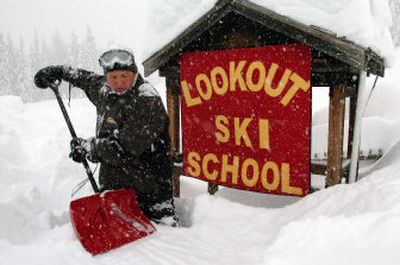Wetter winter graces Northwest

For the first time in two years, Inland Northwest mountains have their normal winter mantle of snow.
Most of it has fallen in the past three weeks – nearly halfway through what started off as another below-average snow season – prompting federal snow tracker Scott Pattee to declare an “astonishing” turnaround.
“It’s been a remarkable come-from-behind snowpack season so far,” said Pattee, a water supply specialist with the Natural Resources Conservation Service.
Snowpacks have doubled in the past month and are exponentially deeper than last year’s record dry winter, Pattee said. Quartz Peak north of Spokane, for instance, has nearly 5 feet of snow. Last winter, the site had little more than a crust of snow all the way through March. Blewett Pass near Wenatchee has 10 times the snowpack now as it did last year at this time.
The picture is white and deep up high, but Pattee said there’s an unusual deficit of snow below 4,500 feet because of the stretch of unseasonably warm weather. Spokane has been about 10 degrees higher than average for the past 30 days. Snow in the foothills is especially important for filling streams earlier in spring, he said.
One example of this can be seen in the Selkirk Mountains near Bonners Ferry, Idaho. The Myrtle Creek snowpack measurement site at 3,500 feet has a mere 10 inches of snow. Hidden Lake, which is only 18 miles to the northwest but is 1,500 feet higher, had 7 feet of snow, according to electronic snow monitoring gauges placed by the conservation service.
The high-country snow, though, is considered water in the bank for many, such as farmers, wildland firefighters, power companies and whitewater enthusiasts. This is the snow that keeps creeks and rivers wet long into summertime, said Paul Delaney, president of the Northwest Whitewater Association.
“This is such a good sign,” said Delaney, of Spokane. “We’re ready to get out of this funk we’ve been in. We’ve had two bad years. If this trend continues, we’re going to have a huge snow year and a huge year for river running.”
Although members of the Northwest Whitewater Association have already been out this month paddling the engorged Spokane River, most of the current fun belongs to skiers and snowmobilers. Ski areas and trails are packed across much of the region. In the Methow Valley, some cross-country ski trails have close to 4 feet of snow, said Paula Christen, with the Methow Valley Sport Trails Association.
“It’s really excellent. This is one of the best winters we’ve had in a couple of years,” Christen said, adding that trail use has been high. “Everybody has pent-up skiing energy.”
Washington’s North Cascades have some of the state’s highest snowpack readings, with 218 inches covering Harts Pass. The agriculture-rich lower Yakima River basin has the best overall snowpack readings for the state, coming in at 127 percent of average. The rest of the state is hovering near average for snowpack.
Central and southern Idaho have some of the wettest, heaviest snowpacks in the western United States, with river basins registering up to 175 percent of their average annual snowpacks. The Panhandle is the driest part of the state, but river basins in the north are still registering snowpacks at 96 percent of the average.
“It’s getting a lot tougher to argue we are still in a drought,” Jay Breidenbach of the National Weather Service told a panel of Idaho state officials at a water supply meeting Thursday in Boise. “Most of the drought has been erased in the Pacific Northwest, and in general, we can pretty much declare this drought is over for this part of the country.”
Records are being set in southwestern Idaho at Bear Saddle in the Weiser Basin and South Mountain in the Owyhee Basin. The gauge at Galena Summit in the Sawtooth Range is approaching a record set in 1997, one of the wettest years recorded.
Pomerelle Mountain Resort, in the southern mountains of Idaho, has averaged nearly a foot of new snow a day for the past week and now has 170 inches covering the top of the ski area.
“Mother Nature finally opened up that great big snow wallet of hers,” said Sandy Anderson, one of the resort’s owners.